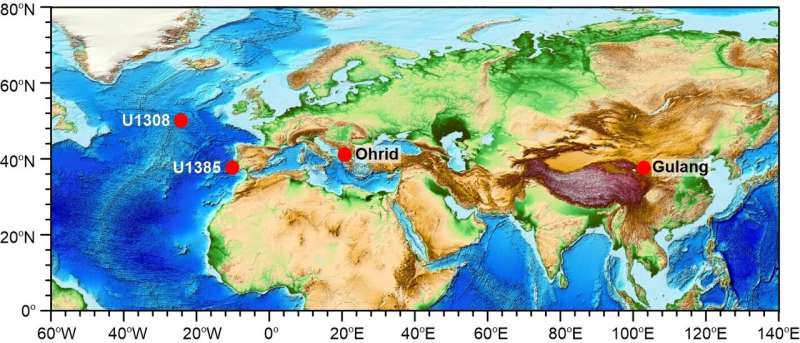Earth's orbit affects millennial climate variability

Abundant geological evidence demonstrates that Earth's climate has experienced millennial-scale variability superimposed on glacial–interglacial fluctuations through the Pleistocene. The magnitude of millennial climate variability has been linked to glacial cycles over the past 800 thousand years (kyr).
For the period before the Mid-Pleistocene Transition, when global glaciations were less pronounced but more frequent, scientists had been unable to identify the linkage between abrupt climate changes and ice-age cycles.
Recently, however, scientists from China, the United States, the United Kingdom and Switzerland found that the magnitude of millennial climate variability was persistently influenced by variations in the precession and obliquity of the Earth through the Pleistocene.
Their study was published in Nature Geoscience on Nov. 1.
The researchers compared four climate-sensitive elemental ratios from two marine cores (U1308 in the North Atlantic and U1385 on the Iberian Margin) and two continental sedimentary records (Lake Ohrid on the Balkan Peninsula and Gulang loess on the western Chinese Loess Plateau).
"We selected these four records because of their high sedimentation rates, long duration, availability of centennial-resolution proxy datasets, and high sensitivity of elemental ratios to abrupt climate changes," said Prof. Sun Youbin from the Institute of Earth Environment of the Chinese Academy of Sciences, the first author of the study.
By synchronizing these four proxy records to Chinese speleotheom δ18O records and the North Atlantic ice-rafted debris events, the researchers evaluated how millennial climate variability evolved over the last 1.5 million years (Myr).
"Combination of these four proxies into a new millennial climate variability stack offers a credible reference for further assessing the dynamical interactions between orbital and millennial climate variability," said Prof. Sun.
The land-ocean synthesis of these four climate-sensitive proxy records not only demonstrates the persistent and pervasive nature of millennial climate variability over the past 1.5 Myr but also highlights the differing influences of ice sheets and orbital geometry on the magnitude of abrupt climate events through the Pleistocene.
Before the Mid-Pleistocene Transition, the magnitude of abrupt climate changes was influenced mainly by changes in the orbital parameters of obliquity and precession, whereas after the Mid-Pleistocene Transition both the extent of global glaciation and orbital configurations had great potential for amplifying abrupt climate changes.
A modeling study published at the same time suggests that orbital-induced changes in both high- and low-latitude processes might amplify the magnitude of millennial climate variability.
More information: Youbin Sun et al, Persistent orbital influence on millennial climate variability through the Pleistocene, Nature Geoscience (2021). DOI: 10.1038/s41561-021-00794-1
Journal information: Nature Geoscience
Provided by Chinese Academy of Sciences




















